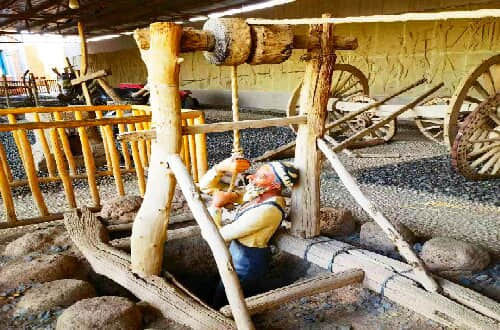Gaochang Ancient City

Gaochang Ancient City is about 40 kilometers away from Turpan City, with a total area of about 2.2 million square meters. The ancient city ruins are surrounded by mountains on all sides, located in a low-lying area, and feature a temperate continental climate. It is dry with little rainfall all year round. As one of the important urban ruins in the ancient Western Regions, it has a time span of about 1,400 years and holds extremely high historical, cultural, and archaeological value.
- Chinese name: 高昌故城 Gāo Chāng Gù Chéng
- Suggested time: Half a day
- Ticket: 70 yuan per person (Note: There may be different price policies for special groups like students and seniors. It's advisable to check on-site or through official tourism channels.)
- Open hours: 10:00-19:00
- The best time to visit: March to May, September to November
- Address: 1 kilometer east of Sanbao Township, Gaochang District, Turpan, Xinjiang
- How to get there: Renting a car or taking a taxi is a more convenient option. It takes about an hour's drive from the city center of Turpan.
- Surroundings: Astana Cemetery, Flaming Mountains
Highlights of Gaochang Ancient City
Taicang Pagoda
In the southeast corner of Gaochang Ancient City stands a 13-meter-high rammed-earth Buddhist pagoda, once a spiritual landmark of this important Silk Road town—Taicang Pagoda. Built with rammed earth in a square shape, the arched Buddhist niche in the middle of the pagoda is now empty, but the solemn outline of the ancient Buddha statue can still be faintly discerned.
Southwest Grand Buddhist Temple
 Gaochang Ancient City
Gaochang Ancient CityHere you will see one of the best-preserved ruins in the Gaochang Ancient City. Located at the southwest corner of the outer city, this large temple site complex covers an area of about 10,000 square meters. It consists of a gate, courtyard, lecture hall, scripture repository, main hall, and monastic quarters, with relatively intact preservation. The temple's doors, windows, and Buddhist niches remain clearly distinguishable. In ancient times, the four walls of the temple were painted with adorned with Buddhist stories. Despite thousands of years passing, faint traces of these colorful murals can still be seen at the base of the city wall.
Khan Fort
Khan Fort is located at the northernmost end. Compared with other scenic spots, its integrity is slightly poorer. The existing western, southern, and northern walls are the remains of the palace city in Gaochang Ancient City. The palace city is rectangular in plan, with a perimeter of about 700 meters. Several remnants of the western wall still exist, roughly indicating the traces of the ancient city walls. Many tall palace foundations preserved in the palace city are generally 3.5 to 4 meters high, and the thickness of the rammed layer is about 35 to 48 centimeters. It can be seen that this is the remains of a four-story palace building.
Educational Value
The square rammed-earth structure of Taicang Pagoda integrates the architectural styles of Central Plains Buddhist pagodas and Western Regions, serving as a tangible teaching material for the fusion of multicultural art.
Activities to do at Gaochang Ancient City
 Karez
KarezKarez Study Tour: Combined with the Karez relics around the Gaochang Ancient City, carry out Karez research activities, draw a spatial relationship map between Karez and urban water systems, and understand the survival wisdom of "prospering due to water" in arid areas.
Rammed-Earth Architecture Experience: Organize "rammed-earth architecture experience" activities, simulate ancient rammed-earth techniques with simple tools, understand the proportioning and construction technology of raw earth materials, and feel the wisdom of ancient craftsmen.
Drop us a line and we'll connect you with the top China expert in no time!